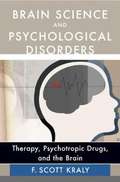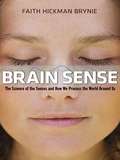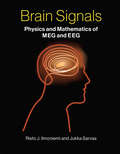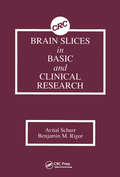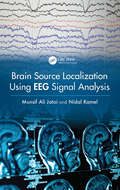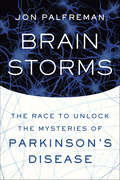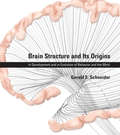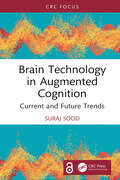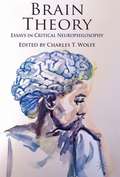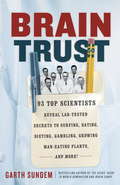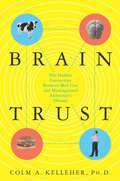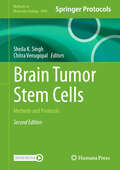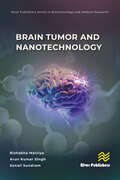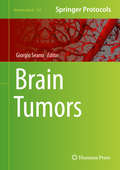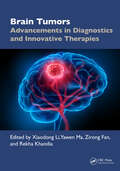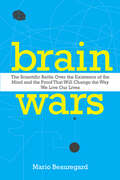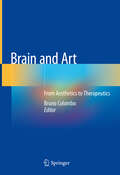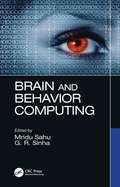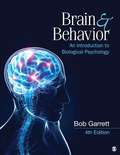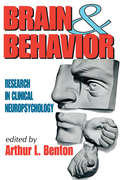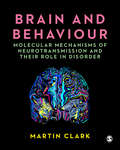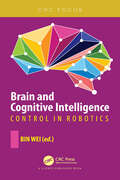- Table View
- List View
Brain Science and Psychological Disorders: Therapy, Psychotropic Drugs, and the Brain
by F. KralyReaders with little background in neuroscience and physiology may find themselves at a loss trying to navigate between the knowns and the unknowns when it comes to understanding the intricacies of the brain. <P><P>Brain Science and Psychological Disorders demystifies the field of neuroscience, offering a brisk, digestible narrative of how malfunctioning neurons and neurochemicals can result in psychological disorders. In doing so, Kraly explains the roles of pharmacotherapy and psychotherapy in helping to repair various mental health problems, including depression and mania, anxiety, substance abuse, bulimia and anorexia, ADHD, and schizophrenia. Also available in paperback as The Unwell Brain: Understanding the Psychobiology of Mental Health.
Brain Sense: The Science of the Senses and How We Process the World Around Us
by Faith Hickman BrynieComplex and crucially important, the senses collect the massive amount of information we need to navigate daily life, and serve as a filter between our inner selves and the larger world. But the science of how the senses work has been little understood—until now. New research is rapidly uncovering fascinating insights into how the brain processes sensory information. It’s not simply a matter of the brain controlling the senses; the senses actually stimulate brain development. For example, the brain’s sound-processing centers mature properly only when sound impulses trigger them to do so—which is why cochlear implants are best used before the age of three. Brain Sense reveals this and a wealth of findings on how the brain and senses interact, as it examines each of the five major senses: touch, smell, taste, vision, and hearing. With eloquent writing and gripping stories, the author deploys a rare gift for explaining complex scientific ideas in a way that is clear and comprehensible. She introduces the scientists at the forefront of “brain sense” studies—neurologists, brain mappers, biochemists, physicians, cognitive psychologists, and others—as well as real-life people who are contributing to the research and benefiting from its practical applications, such as haptic devices to assist people who have lost limbs or rehabilitative software for those who have suffered impairments to their motion vision. You’ll find new research that explains: • Why placebos work by changing the way the brain processes pain • How humans respond to pheromones in the same manner as other animals • How taste is highly influenced by expectations of taste • Why color significantly aids the ability to remember an object • How the capacity for language is already at work in newborn babies • What happens in the brain to produce sensory experiences such as déjà vu and phantom limb pain • And much more Expansive and enlightening, Brain Sense shows us that the brain is both flexible and variable, and the reality that we construct based on inputs gathered from the senses differs from person to person. It sheds a much-needed light on the elusive workings of the extraordinary human brain.
Brain Sex: The Real Difference Between Men and Women
by Anne Moir David JesselThis book explains differences between the brains of men and women.
Brain Signals: Physics and Mathematics of MEG and EEG (The\mit Press Ser.)
by Risto J. Ilmoniemi Jukka SarvasA unified treatment of the generation and analysis of brain-generated electromagnetic fields.In Brain Signals, Risto Ilmoniemi and Jukka Sarvas present the basic physical and mathematical principles of magnetoencephalography (MEG) and electroencephalography (EEG), describing what kind of information is available in the neuroelectromagnetic field and how the measured MEG and EEG signals can be analyzed. Unlike most previous works on these topics, which have been collections of writings by different authors using different conventions, this book presents the material in a unified manner, providing the reader with a thorough understanding of basic principles and a firm basis for analyzing data generated by MEG and EEG.The book first provides a brief introduction to brain states and the early history of EEG and MEG, describes the generation of electromagnetic fields by neuronal activity, and discusses the electromagnetic forward problem. The authors then turn to EEG and MEG analysis, offering a review of linear and matrix algebra and basic statistics needed for analysis of the data, and presenting several analysis methods: dipole fitting; the minimum norm estimate (MNE); beamforming; the multiple signal classification algorithm (MUSIC), including RAP-MUSIC with the RAP dilemma and TRAP-MUSIC, which removes the RAP dilemma; independent component analysis (ICA); and blind source separation (BSS) with joint diagonalization.
Brain Slices in Basic and Clinical Research
by Avital Schurr Benjamin M. RigorBrain Slices in Basic and Clinical Research describes advancements in the field of brain function and dysfunction through use of central nervous system slice preparations. Topics are authored by leading scientists and include the following:Mechanisms of synaptic plasticity as the basis of memory processesChaos and synaptic variabilityBrain calcium currentsGlutamate receptorsPathophysiology of excitotoxinsCerebral hypoxia-ischemiaNeuronal injuryFree radicalsOptical methods of measuring brain metabolismVoltammetry in brain slicesCalcium imagingPatch-clamp recording and application of macromolecules through patch-clamp pipettes in brain slicesIntracellular double labeling of various neuronal populationsUse of brain slices in teaching neurophysiological methodsMost of the topics are published in book format for the first time, and some of the techniques are more fully detailed than in any other book.
Brain Source Localization Using EEG Signal Analysis
by Munsif Ali Jatoi Nidal KamelOf the research areas devoted to biomedical sciences, the study of the brain remains a field that continually attracts interest due to the vast range of people afflicted with debilitating brain disorders and those interested in ameliorating its effects. To discover the roots of maladies and grasp the dynamics of brain functions, researchers and practitioners often turn to a process known as brain source localization, which assists in determining the source of electromagnetic signals from the brain. Aiming to promote both treatments and understanding of brain ailments, ranging from epilepsy and depression to schizophrenia and Parkinson’s disease, the authors of this book provide a comprehensive account of current developments in the use of neuroimaging techniques for brain analysis. Their book addresses a wide array of topics, including EEG forward and inverse problems, the application of classical MNE, LORETA, Bayesian based MSP, and its modified version, M-MSP. Within the ten chapters that comprise this book, clinicians, researchers, and field experts concerned with the state of brain source localization will find a store of information that can assist them in the quest to enhance the quality of life for people living with brain disorders.
Brain Storm: The Flaws in the Science of Sex Differences
by Rebecca M. Jordan-YoungFemale and male brains are different, thanks to hormones coursing through the brain before birth. That’s taught as fact in psychology textbooks, academic journals, and bestselling books. And these hardwired differences explain everything from sexual orientation to gender identity, to why there aren’t more women physicists or more stay-at-home dads. In this compelling book, Rebecca Jordan-Young takes on the evidence that sex differences are hardwired into the brain. Analyzing virtually all published research that supports the claims of “human brain organization theory,” Jordan-Young reveals how often these studies fail the standards of science. Even if careful researchers point out the limits of their own studies, other researchers and journalists can easily ignore them because brain organization theory just sounds so right. But if a series of methodological weaknesses, questionable assumptions, inconsistent definitions, and enormous gaps between ambiguous findings and grand conclusions have accumulated through the years, then science isn’t scientific at all. Elegantly written, this book argues passionately that the analysis of gender differences deserves far more rigorous, biologically sophisticated science. “The evidence for hormonal sex differentiation of the human brain better resembles a hodge-podge pile than a solid structure…Once we have cleared the rubble, we can begin to build newer, more scientific stories about human development.”
Brain Storms: The Race to Unlock the Mysteries of Parkinson's Disease
by Jon Palfreman“The best and clearest book I’ve encountered on the current state of knowledge about Parkinson’s Disease . . . a master storyteller.” —The Tampa TribuneSeven million people worldwide suffer from Parkinson’s, and doctors, researchers, and patients continue to hunt for a cure. In Brain Storms, Peabody Award–winning journalist Jon Palfreman tells their story—a story that became his own when he was diagnosed with the debilitating illness.Palfreman chronicles how scientists have worked to crack the mystery of what was once called the shaking palsy, from the earliest clinical descriptions of tremors, gait freezing, and micrographia to the cutting edge of neuroscience, and charts the victories and setbacks of a massive international effort to best the disease. He takes us back to the 1950s and the discovery of L-dopa. He delves into other therapeutic approaches to this perplexing condition, from partial lobotomies and deep brain stimulation to neural grafting. And he shares inspiring stories of brave individuals living with Parkinson’s, from a former professional ballet dancer who tricks her body to move freely again to a patient who cannot walk but astounds doctors when he rides a bicycle with no trouble at all.The race is on to stop or reverse neurodegenerative conditions like Parkinson’s and Alzheimer’s. Brain Storms is the long-overdue, riveting, and deeply personal story of that race, and a passionate, insightful look into the lives of those affected.“Well written and poignant.” —The Wall Street Journal“[Palfreman] has an excellent grasp on the science behind the disease . . . but it is as a human story that the book is most compelling.” —The Times Literary Supplement“Clean prose, clear thought and fascinating stories.” —The Miami Herald“Extraordinary case studies abound.” —Nature“Fast-paced, captivating . . . part scientific investigation, part medical detective story, and part memoir . . . it opens wide a window into the world of Parkinson’s.” —Publishers Weekly (starred review)
Brain Structure and Its Origins: in Development and in Evolution of Behavior and the Mind
by Gerald E. SchneiderAn introduction to the brain's anatomical organization and functions with explanations in terms of evolutionary adaptations and development.This introduction to the structure of the central nervous system demonstrates that the best way to learn how the brain is put together is to understand something about why. It explains why the brain is put together as it is by describing basic functions and key aspects of its evolution and development. This approach makes the structure of the brain and spinal cord more comprehensible as well as more interesting and memorable. The book offers a detailed outline of the neuroanatomy of vertebrates, especially mammals, that equips students for further explorations of the field.Gaining familiarity with neuroanatomy requires multiple exposures to the material with many incremental additions and reviews. Thus the early chapters of this book tell the story of the brain's origins in a first run-through of the entire system; this is followed by other such surveys in succeeding chapters, each from a different angle. The book proceeds from basic aspects of nerve cells and their physiology to the evolutionary beginnings of the nervous system to differentiation and development, motor and sensory systems, and the structure and function of the main parts of the brain. Along the way, it makes enlightening connections to evolutionary history and individual development. Brain Structure and Its Origins can be used for advanced undergraduate or beginning graduate classes in neuroscience, biology, psychology, and related fields, or as a reference for researchers and others who want to know more about the brain.
Brain Technology in Augmented Cognition: Current and Future Trends
by Suraj SoodBrain Technology in Augmented Cognition: Current and Future Trends informs engineers interested in human-computer interaction about the current state of augmented cognition. Its scope includes recent advances in electroencephalography (EEG), neural network (NN), and brain-computer interface (BCI) brain technologies.The title explores in detail each technological approach to augmented cognition and offers conclusions to them, summarizing the work and their respective futures. Augmented cognition research often includes the use of brain technology, and this book addresses advances in augmented cognition and its applications. It details recent uses of EEG, NN, and BCI in the field and how they may augment user, researcher, and practitioner cognition. Focusing on the use of EEG for eye-tracking, NN logic, and the BCI application of motor-imagery (MI) and discussing challenges and opportunities relevant to such applications, the title is a useful introduction to the subject matter.This is an engaging read for any student, researcher or academic in the fields of engineering, augmented cognition, human-computer interaction and human factors/ergonomics who will learn the basics and key concepts of augmented cognition through this simple and straightforward title.
Brain Theory
by Charles T. WolfeFrom its beginnings until the present day, neuroscience has always had a special relationship to philosophy. And philosophy has long puzzled over the relation between mind and brain (and by extension, the relation of cerebral processes to freedom, morals, and justice, but also to perception and art). This volume presents some of the state-of-the-art reflections on philosophical efforts to 'make sense' of neuroscience, as regards issues including neuroaesthetics, neuroethics and neurolaw, but also more critical, evaluative perspectives on topics such as the social neuroscience of race, neurofeminism, embodiment and collaboration, memory and pain, and more directly empirical topics such as neuroconstructivism and embodied robotics. Brain theory as presented here is neither mere commentary on the state of the sciences, nor armchair philosophical reflection on traditional topics. It is more pluralistic than current philosophy of neuroscience (or neurophenomenology), yet more directly engaged with empirical, indeed experimental matters than socio-cultural discussions of 'brainhood' or representations of the brain.
Brain Trust: 93 Top Scientists Reveal Lab-tested Secrets to Surfing, Dating, Dieting, Gambling, Growing Man-eating Plants, and More!
by Garth SundemBlind Them...with SCIENCE! How much better would your life be if you had an army of Nobel Laureates, MacArthur 'geniuses' and National Medal of Science winners whispering tips in your ear about your body language, or how to resist that impulse purchase you'll regret tomorrow, or when to sell your car--or even helping you trick your spouse into doing the dishes? With this mighty little tome, you can have the next best thing--because Brain Trust is packed with bite-sized scientific wisdom on our everyday challenges, hand-delivered to you direct from the galaxy's biggest brains. Based entirely on interviews with an incredible lineup of luminaries from the fields of neuroscience, economics, anthropology, music, mathematics, and more, Brain Trust is full of cutting-edge science that'll help you see the real world better--and smarter. Discover: --what advanced math can teach you about getting all your chores done today --how creating a 'future self' can help you shop smarter at the grocery store--what prairie voles can teach us about love--how the science of happiness can help you trick lawyers into doing charity work --the components of gullibility, and how they can help you scam-proof yourself--the secrets to building your very own army of cyborg beetles --how memetic information can help you exploit altruism for good...or evil--why eating for eight hours can help you lose weight--the behavioral economics behind selling your junk for big bucks on eBay--how to get more pleasure for less price...And much, much more.
Brain Trust: The Hidden Connection Between Mad Cow and Misdiagnosed Alzheimer's Disease
by Colm A. KelleherWhen the cattle-borne sickness known as Mad Cow Disease first appeared in America in 2003, authorities were quick to assure the nation that the outbreak was isolated, quarantined, and posed absolutely no danger to the general public. What we were not told was that the origins of the sickness may already have been here and suspected for a quarter of a century. This illuminating exposé of the threat to our nation's health reveals for the first time how Mad Cow Disease (a.k.a. Bovine Spongiform Encephalopathy) has jumped species, infecting humans in the form of Creutzfeldt-Jakob Disease (CJD), and may be hidden in the enormous increase in the number of Alzheimer's cases since 1979. Detailing the history and biology of Mad Cow Disease, Brain Trust discloses how an investigation into the mysterious deaths in a group of cannibals in a remote part of the world evolved into a research program in the United States that may have had unforeseen and frightening consequences. The shocking questions examined include: Have millions of Americans already been exposed to the prions known to cause Mad Cow Disease through years of eating tainted beef? Does the epidemic of prion disease spreading like wildfire through the nation's deer and elk pose a threat to hunters and venison eaters? Are the cattle mutilations discovered in the last 30 years part of a covert, illegal sampling program designed to learn how far the deadly prions have spread throughout the nation's livestock and beef products? Exposing the devastating truth about Mad Cow Disease and a new theory of the possible consequences of a little-known government research program and the potential national health catastrophe that may be the result, Brain Trust inoculates Americans with an effective cure: the truth.
Brain Tumor Stem Cells: Methods and Protocols (Methods in Molecular Biology #2944)
by Sheila K. Singh Chitra VenugopalThis updated volume explores the technically challenging study of brain tumor stem cells (BTSCs) with their unique capacity to self-renew, proliferate, and initiate tumor formation. The book collects up-to-date methodologies to isolate and propagate BTSCs and to study them using various cutting-edge techniques, in service of bringing us closer to translating the discoveries made from these cells into new therapeutic options for brain cancer patients. Written for the highly successful Methods in Molecular Biology series, chapters include introductions to their respective topics, lists of the necessary materials and reagents, step-by-step and readily reproducible laboratory protocols, and tips on troubleshooting and avoiding known pitfalls. Authoritative and up-to-date, Brain Tumor Stem Cells: Methods and Protocols, Second Edition provides a comprehensive understanding of the skills and techniques needed to unlock data from this most informative subset of cells.
Brain Tumor and Nanotechnology (River Publishers Series in Biotechnology and Medical Research)
by Arun Kumar Singh Rishabha Malviya Sonali SundramBrain Tumors and Nanotechnology explores the complex world of brain tumors and the ground-breaking role that nanotechnology is playing in both detection and treatment. It offers comprehensive and up-to-date strategies in the treatment of brain tumors, with a special emphasis on the revolutionary impact of nanotechnology. It begins with an in-depth analysis of the anatomy of the brain and nervous system, highlighting the constituents of the central nervous system (CNS) such as neurons and glial cells. It also offers a thorough understanding of the intricate structure of the human brain, including the hemispheres, brainstem, diencephalon, and ventricular system. It then reveals the understanding of the complicated nature of brain tumors and the potential for nanotechnology to revolutionize their diagnosis and treatment. Brain Tumors and Nanotechnology will be a longstanding valuable resource for researchers, medical professionals, and students in the field.
Brain Tumors (Neuromethods #158)
by Giorgio SeanoThis volume explores the latest models and techniques used to study brain tumor biology. Chapters in this book are organized into four sections: in vivo models, ex vivo models, treatments in mice, and clinical imaging. Some of the topics covered in this book are in vivo preclinical models of lower-grade gliomas, medulloblastoma, and brain metastases; ex vivo methods for glioblastoma patient-derived cell lines and organotypic brain cultures for metastasis; in vivo treatments of preclinical models that assess neurological function, dynamic immunotherapy, and neurological impacts of brain irradiation; and clinical imaging and modeling, such as biomechanics and vascular perfusion. In the Neuromethods series style, chapters include the kind of detail and key advice from the specialists needed to get successful results in your laboratory. Cutting-edge and practical, Brain Tumors is a valuable resource that will help readers understand the heterogeneity of the techniques used to study the complexity of brain tumors.
Brain Tumors: Advancements in Diagnostics and Innovative Therapies
by Xiaodong Li Yawen Ma Zirong Fan Rekha KhandiaThis book offers a comprehensive exploration of brain tumors, beginning with a foundational understanding of their pathophysiology and extending through the latest advancements in diagnosis and treatment. The chapters examine the underlying mechanisms that drive the development and progression of brain tumors and present a detailed analysis of the incidence, distribution, and potential risk factors associated with brain tumors. The book explores the intricate relationship between brain tumors and visual disorders, and reviews the critical role of advanced imaging technologies in diagnosing brain tumors, evaluating the strengths and limitations of various modalities such as MRI and PET scans. Additionally, the book evaluates the effectiveness and precision of radiosurgery in targeting brain tumors, discussing its benefits and challenges in the context of non-invasive cancer treatment. The chapters also introduce us to antisense oligonucleotides as a novel therapeutic strategy, outlining their mechanism of action and potential to silence cancer-driving genes. The book highlights the latest developments in nanotechnology for brain tumor diagnosis, emphasizing the use of nanomaterials to enhance imaging quality and specificity.Key Features: Provides a thorough exploration of brain tumors, from basic pathophysiology to advanced treatment options Presents detailed analyses of the incidence, distribution, and potential risk factors associated with brain tumors Discusses the critical role of imaging technologies, including MRI and PET scans, in the diagnosis of brain tumors Introduces novel therapeutic strategies such as radiosurgery and antisense oligonucleotides for targeting brain tumors Examines strategies to overcome the blood–brain barrier for effective drug delivery Toward the end, the book covers challenges of and strategies for delivering therapeutic agents across the blood–brain barrier and discusses phytochemicals in brain tumor treatment. This book serves as a useful source for researchers and students in oncology and neuroscience.
Brain Wars: The Scientific Battle Over the Existence of the Mind and the Proof That Will Change the Way We Live Our Lives
by Mario BeauregardThe brain can be weighed, measured, scanned, dissected, and studied. The mind that we conceive to be generated by the brain, however, remains a mystery. It has no mass, no volume, and no shape, and it cannot be measured in space and time. Yet it is as real as neurons, neurotransmitters, and synaptic junctions. It is also very powerful.—from Brain WarsIs the brain "a computer made of meat," and human consciousness a simple product of electrical impulses? The idea that matter is all that exists has dominated science since the late nineteenth century and led to the long-standing scientific and popular understanding of the brain as simply a collection of neurons and neural activity. But for acclaimed neuroscientist Mario Beauregard, Ph.D., along with a rising number of colleagues and others, this materialist-based view clashes with what we feel and experience every day. In Brain Wars, Dr. Beauregard delivers a paradigm-shifting examination of the role of the brain and mind. Filled with engaging, surprising, and cutting-edge scientific accounts, this eye-opening book makes the increasingly indisputable case that our immaterial minds influence what happens in our brains, our bodies, and even beyond our bodies. Examining the hard science behind "unexplained" phenomena such as the placebo effect, self-healing, brain control, meditation, hypnosis, and near-death and mystical experiences, Dr. Beauregard reveals the mind's capabilities and explores new answers to age-old mind-body questions. Radically shifting our comprehension of the role of consciousness in the universe, Brain Wars forces us to consider the immense untapped power of the mind and explore the profound social, moral, and spiritual implications that this new understanding holds for our future.
Brain and Art: From Aesthetics to Therapeutics
by Bruno ColomboThis book analyzes and discusses in detail art therapy, a specific tool used to sustain health in affective developments, rehabilitation, motor skills and cognitive functions. Art therapy is based on the assumption that the process of making art (music, dance, painting) sparks emotions and enhances brain activity. Art therapy is used to encourage personal growth, facilitate particular brain areas or activity patterns, and improve neural connectivity. Treating neurological diseases using artistic strategies offers us a unique option for engaging brain structural networks that enhance the brain’s ability to form new connections. Based on brain plasticity, art therapy has the potential to increase our repertoire for treating neurological diseases. Neural substrates are the basis of complex emotions relative to art experiences, and involve a widespread activation of cognitive and motor systems. Accordingly, art therapy has the capacity to modulate behavior, cognition, attention and movement. In this context, art therapy can offer effective tools for improving general well-being, quality of life and motivation in connection with neurological diseases. The book discusses art therapy as a potential group of techniques for the treatment of neurological disturbances and approaches the relationship between humanistic disciplines and neurology from a holistic perspective, reflecting the growing interest in this interconnection.
Brain and Behavior Computing
by Mridu SahuBrain and Behavior Computing offers insights into the functions of the human brain. This book provides an emphasis on brain and behavior computing with different modalities available such as signal processing, image processing, data sciences, statistics further it includes fundamental, mathematical model, algorithms, case studies, and future research scopes. It further illustrates brain signal sources and how the brain signal can process, manipulate, and transform in different domains allowing researchers and professionals to extract information about the physiological condition of the brain. Emphasizes real challenges in brain signal processing for a variety of applications for analysis, classification, and clustering. Discusses data sciences and its applications in brain computing visualization. Covers all the most recent tools for analysing the brain and it’s working. Describes brain modeling and all possible machine learning methods and their uses. Augments the use of data mining and machine learning to brain computer interface (BCI) devices. Includes case studies and actual simulation examples. This book is aimed at researchers, professionals, and graduate students in image processing and computer vision, biomedical engineering, signal processing, and brain and behavior computing.
Brain and Behavior: An Introduction to Biological Psychology (Fourth Edition)
by Bob L. GarrettThe Fourth Edition of Brain & Behavior: An Introduction to Biological Psychology by Bob Garrett showcases our rapidly increasing understanding of the biological foundations of behavior, engaging students immediately with easily accessible content. Bob Garrett uses colorful illustrations and thought-provoking facts while maintaining a "big-picture" approach that students will appreciate. Don't be surprised when they reach their "eureka" moment and exclaim, "Now I understand what was going on with Uncle Edgar!" " [T]he topic coverage is excellent. It is what a student taking an Introductory Biological Psychology course should walk away with. " --William Meil, Indiana University of Pennsylvania "I absolutely love this book. I think it is head and shoulders above any other. . . . The book is just right. I have used every edition so far and students seem to read it and grasp the concepts well. It is clearly written, well illustrated, and explains concepts in an engaging and understandable way. The text reads like it should--a wonderfully written book. It almost reads like a novel, progressing through the topics with a fluency that is rare. It's perfect for my students. " --Carol L. DeVolder, St. Ambrose University "The text is well organized and has excellent artwork depicting complex brain functions. " --Dr. Catherine Powers Ozyurt, Bay Path College "Excellent use of artwork, good coverage of a range of topics within each chapter. " --M. Foster Olive, Arizona State University
Brain and Behavior: Research in Clinical Neuropsychology
by Arthur L. BentonResearch in the field of clinical neuropsychology has greatly advanced understanding of the complex relationships between brain functions and human behavior. This edited collection, originally published in the early days of this dynamic field, draws from the findings of clinical study, animal experimentation, and developmental observation to clarify the relationships between brain and behavior. The result is a report on the state of knowledge at that time, and a barometer of how far the field has come.The book's contributors include some of the leading figures in the field of human and developmental neuropsychology. They present comprehensive reviews of salient topics on which they themselves have done important investigative work. An introduction by Klaus Poeck describes the historical evolution of clinical neuropsychology and discusses the status of the field from both substantive and methodological standpoints. George Ettlinger and Colin Blakemore describe understanding of inter-hemispheric relations as demonstrated by studies in animals and man. Sidney Weinstein discusses the phenomenon of the "phantom" in patients with amputated body parts and its implications for the concept of body image.Norman Geschwind, who was instrumental in reviving interest in the anatomical approach to aphasia, focuses on some unsolved anatomical problems and suggests needed clinical and experimental study. Arthur L. Benton outlines questions concerning constructional apraxia. Josephine Semmes offers a brilliant reformulation on whether there are discrete basic types of somatosensory function. Luigi Vignolo presents a masterful analysis of the concept of auditory agnosia and describes his own research in this area. Concentrating on a few important problem areas, each of which is intensively probed, this book offers valuable insight into how research advances understanding of the neuroanatomical bases of behavior.
Brain and Behaviour: Molecular Mechanisms of Neurotransmission and their Role in Disorder
by Martin ClarkWant to understand the biological processes that underpin our behaviour? Look no further! Neurotransmitters are a core element of biological psychology and essential for the correct operation of brain circuits. This textbook focuses on eight core neurotransmitters and explores the machinery underpinning their function. This includes how they are synthesised, packaged, and facilitate communication between neurons. Each chapter focuses on a single neurotransmitter, outlining its machinery and discussing what research suggests about how the alteration of this machinery may contribute to various atypical behavioural states. This structure will help guide the reader through complex ideas in a clear and comprehensive manner. From Dopamine to Nitric Oxide, and from Acetylcholine to Serotonin, Brain and Behaviour places specific focus on how alterations in neurotransmitters can contribute to specific atypical behaviour such as ASD, Epilepsy, Depression, and Addiction. It is essential reading for any student of neuropsychology, neuroscience, or biological psychology. Brain and Behaviour also includes features to help enhance your understanding of neurotransmitters, such as: - Research methods focus boxes - Famous researcher spotlight - Test yourself questions Martin Clark is Lecturer in Neurobiology at the University of Central Lancashire.
Brain and Behaviour: Molecular Mechanisms of Neurotransmission and their Role in Disorder
by Martin ClarkWant to understand the biological processes that underpin our behaviour? Look no further! Neurotransmitters are a core element of biological psychology and essential for the correct operation of brain circuits. This textbook focuses on eight core neurotransmitters and explores the machinery underpinning their function. This includes how they are synthesised, packaged, and facilitate communication between neurons. Each chapter focuses on a single neurotransmitter, outlining its machinery and discussing what research suggests about how the alteration of this machinery may contribute to various atypical behavioural states. This structure will help guide the reader through complex ideas in a clear and comprehensive manner. From Dopamine to Nitric Oxide, and from Acetylcholine to Serotonin, Brain and Behaviour places specific focus on how alterations in neurotransmitters can contribute to specific atypical behaviour such as ASD, Epilepsy, Depression, and Addiction. It is essential reading for any student of neuropsychology, neuroscience, or biological psychology. Brain and Behaviour also includes features to help enhance your understanding of neurotransmitters, such as: - Research methods focus boxes - Famous researcher spotlight - Test yourself questions Martin Clark is Lecturer in Neurobiology at the University of Central Lancashire.
Brain and Cognitive Intelligence: Control in Robotics
by Bin WeiThe aim of the book is to introduce the state-of-the-art technologies in the field of brain and cognitive intelligence used in robotics control, particularly on studying how the brain learns and controls complex motor skills and how to replicate these in robots. This will be the first book that systematically and thoroughly deals with the above topics. Advances made in the past decades are described. Interesting topics such as human-robot interactions, neurorobotics, biomechanics in robotic control, robot vision, force control, and control and coordination of humanoid robots are covered.
